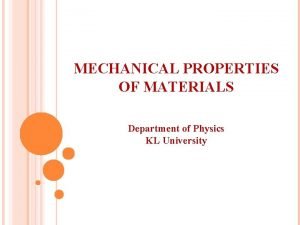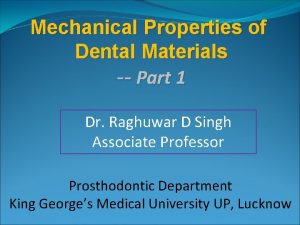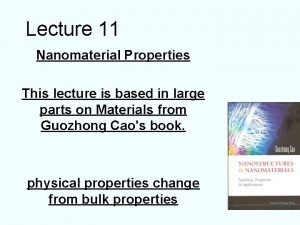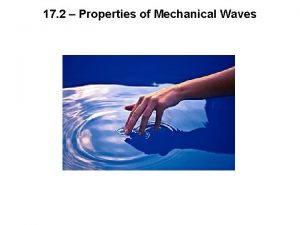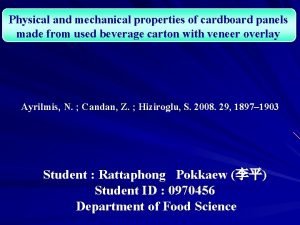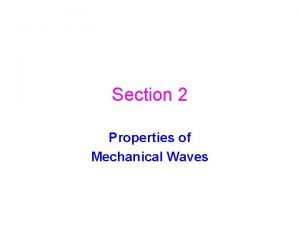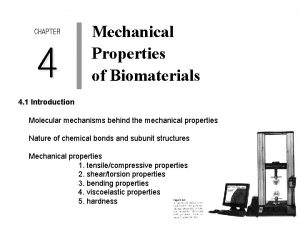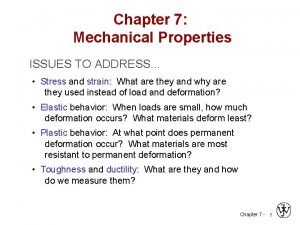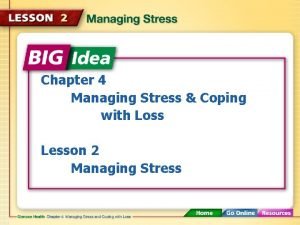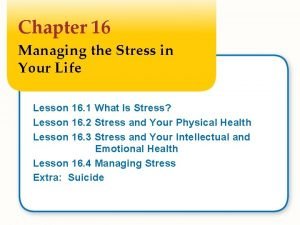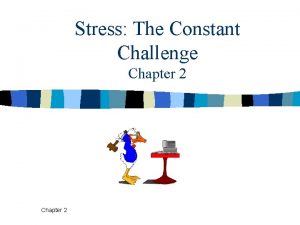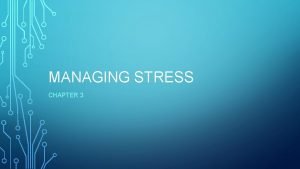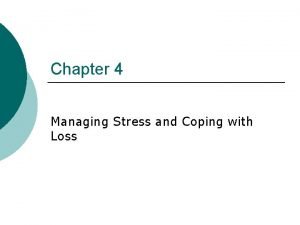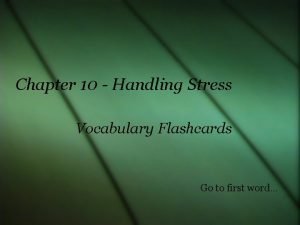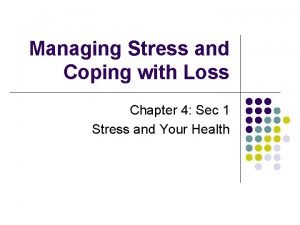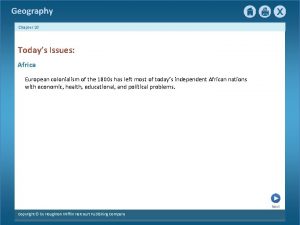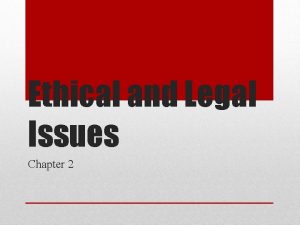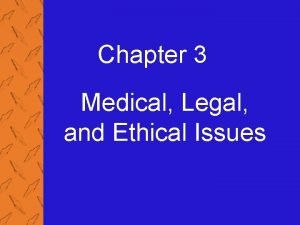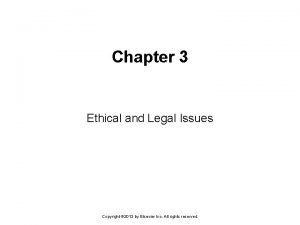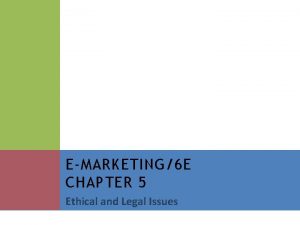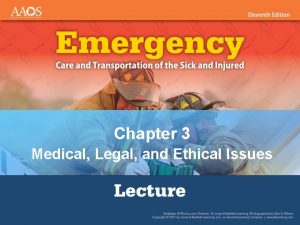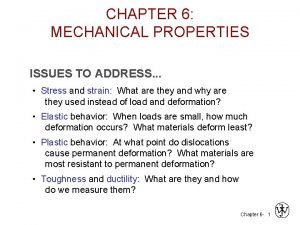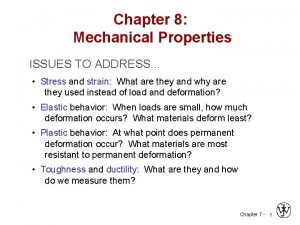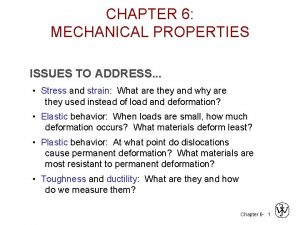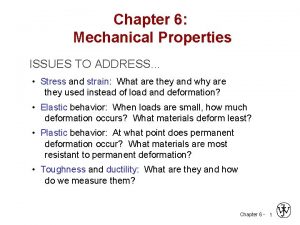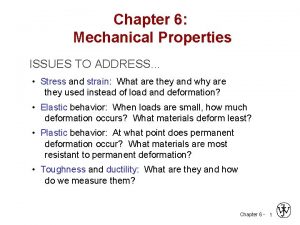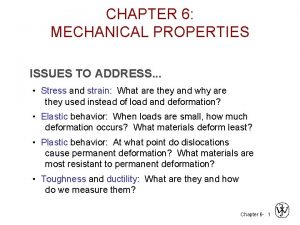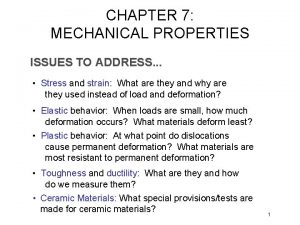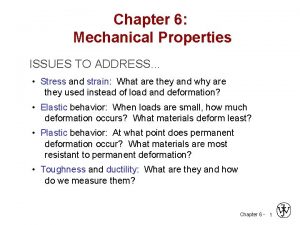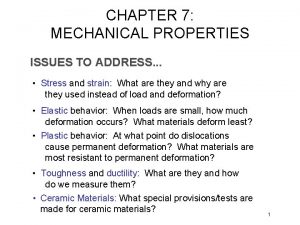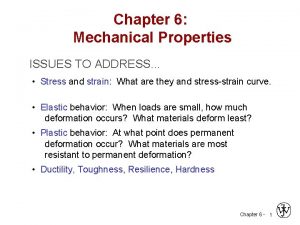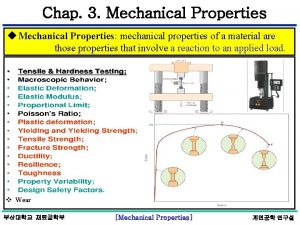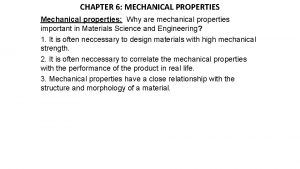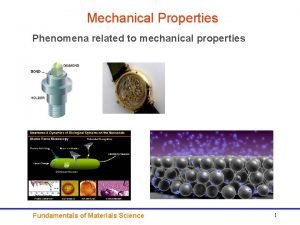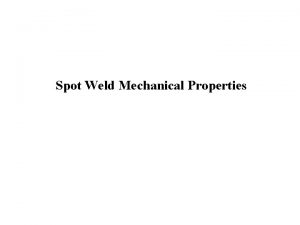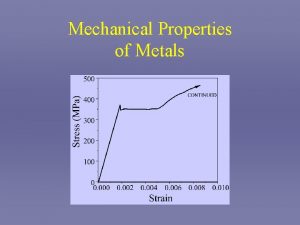Chapter 7 Mechanical Properties ISSUES TO ADDRESS Stress






































- Slides: 38

Chapter 7: Mechanical Properties ISSUES TO ADDRESS. . . • Stress and strain: What are they and why are they used instead of load and deformation? • Elastic behavior: When loads are small, how much deformation occurs? What materials deform least? • Plastic behavior: At what point does permanent deformation occur? What materials are most resistant to permanent deformation? • Toughness and ductility: What are they and how do we measure them? Chapter 7 - 1

Elastic Deformation 1. Initial 2. Small load 3. Unload bonds stretch return to initial d F F Linearelastic Elastic means reversible! d Non-Linearelastic Chapter 7 - 2

Plastic Deformation (Metals) 1. Initial 2. Small load bonds stretch & planes shear delastic + plastic 3. Unload planes still sheared dplastic F F Plastic means permanent! linear elastic dplastic d Chapter 7 - 3

Engineering Stress • Tensile stress, : Ft Ft F Area, Ao Ft Ft lb f N = 2 or = 2 in m Ao original area before loading • Shear stress, t: Fs Fs Fs t= Ao Ft F Stress has units: N/m 2 or lbf /in 2 Chapter 7 - 4

Common States of Stress • Simple tension: cable F F A o = cross sectional area (when unloaded) F = Ao • Torsion (a form of shear): drive shaft M Ac M 2 R Fs Ao Ski lift (photo courtesy P. M. Anderson) Fs t = Ao Note: t = M/Ac. R here. Chapter 7 - 5

OTHER COMMON STRESS STATES (i) • Simple compression: Ao Canyon Bridge, Los Alamos, NM (photo courtesy P. M. Anderson) Balanced Rock, Arches National Park (photo courtesy P. M. Anderson) F = Ao Note: compressive structure member ( < 0 here). Chapter 7 - 6

OTHER COMMON STRESS STATES (ii) • Bi-axial tension: Pressurized tank (photo courtesy P. M. Anderson) • Hydrostatic compression: Fish under water q > 0 z > 0 (photo courtesy P. M. Anderson) h< 0 Chapter 7 - 7

Engineering Strain • Tensile strain: • Lateral strain: d/2 = d Lo wo • Shear strain: -d. L L = wo Lo d. L /2 q g = x/y = tan q x 90º - q y 90º Strain is always dimensionless. Adapted from Fig. 7. 1 (a) and (c), Callister & Rethwisch 3 e. Chapter 7 - 8

Stress-Strain Testing • Typical tensile test machine extensometer • Typical tensile specimen Adapted from Fig. 7. 2, Callister & Rethwisch 3 e. gauge length Adapted from Fig. 7. 3, Callister & Rethwisch 3 e. (Fig. 7. 3 is taken from H. W. Hayden, W. G. Moffatt, and J. Wulff, The Structure and Properties of Materials, Vol. III, Mechanical Behavior, p. 2, John Wiley and Sons, New York, 1965. ) Chapter 7 - 9

Linear Elastic Properties • Modulus of Elasticity, E: (also known as Young's modulus) • Hooke's Law: =E F E Linearelastic F simple tension test Chapter 7 - 10

Poisson's ratio, n • Poisson's ratio, n: L L = metals: ~ 0. 33 ceramics: ~ 0. 25 polymers: ~ 0. 40 Units: E: [GPa] or [psi] : dimensionless - > 0. 50 density increases < 0. 50 density decreases (voids form) Chapter 7 - 11

Mechanical Properties • Slope of stress strain plot (which is proportional to the elastic modulus) depends on bond strength of metal Adapted from Fig. 7. 7, Callister & Rethwisch 3 e. Chapter 7 - 12

Other Elastic Properties • Elastic Shear modulus, G: t M G t=Gg • Elastic Bulk modulus, K: V P = -K Vo g M P K V P Vo • Special relations for isotropic materials: E G= 2(1 + ) E K= 3(1 - 2 ) simple torsion test P P pressure test: Init. vol =Vo. Vol chg. = V Chapter 7 - 13

Young’s Moduli: Comparison Metals Alloys 1200 1000 800 600 400 E(GPa) 200 100 80 60 40 109 Pa Graphite Composites Ceramics Polymers /fibers Semicond Diamond Tungsten Molybdenum Steel, Ni Tantalum Platinum Cu alloys Zinc, Ti Silver, Gold Aluminum Magnesium, Tin Si carbide Al oxide Si nitride Carbon fibers only CFRE(|| fibers)* <111> Si crystal Aramid fibers only <100> AFRE(|| fibers)* Glass -soda Glass fibers only GFRE(|| fibers)* Concrete GFRE* 20 10 8 6 4 2 1 0. 8 0. 6 0. 4 0. 2 CFRE* GFRE( fibers)* Graphite Polyester PET PS PC CFRE( fibers) * AFRE( fibers) * Epoxy only Based on data in Table B. 2, Callister & Rethwisch 3 e. Composite data based on reinforced epoxy with 60 vol% of aligned carbon (CFRE), aramid (AFRE), or glass (GFRE) fibers. PP HDPE PTFE LDPE Wood( grain) Chapter 7 - 14

Useful Linear Elastic Relationships • Simple tension: d = FL o d = - Fw o L EA o F d/2 Ao wo Lo • Simple torsion: a= 2 ML o 4 r o G M = moment a = angle of twist Lo 2 ro d. L /2 • Material, geometric, and loading parameters all contribute to deflection. • Larger elastic moduli minimize elastic deflection. Chapter 7 - 15

Plastic (Permanent) Deformation (at lower temperatures, i. e. T < Tmelt/3) • Simple tension test: Elastic+Plastic at larger stress engineering stress, Elastic initially p permanent (plastic) after load is removed engineering strain, plastic strain Adapted from Fig. 7. 10 (a), Callister & Rethwisch 3 e. Chapter 7 - 16

Yield Strength, y • Stress at which noticeable plastic deformation has occurred. when p = 0. 002 tensile stress, y y = yield strength Note: for 2 inch sample = 0. 002 = z/z z = 0. 004 in engineering strain, p = 0. 002 Adapted from Fig. 7. 10 (a), Callister & Rethwisch 3 e. Chapter 7 - 17

Yield Strength : Comparison Metals/ Alloys 2000 Graphite/ Ceramics/ Semicond Polymers Composites/ fibers 200 Al (6061) ag Steel (1020) hr Ti (pure) a Ta (pure) Cu (71500) hr 100 70 60 50 40 Al (6061) a 30 20 10 Tin (pure) ¨ dry PC Nylon 6, 6 PET PVC humid PP HDPE LDPE Hard to measure, 300 in ceramic matrix and epoxy matrix composites, since in tension, fracture usually occurs before yield. 700 600 500 400 Ti (5 Al-2. 5 Sn) a W (pure) Cu (71500) cw Mo (pure) Steel (4140) a Steel (1020) cd since in tension, fracture usually occurs before yield. 1000 Hard to measure , Yield strength, y (MPa) Steel (4140) qt Room temperature values Based on data in Table B. 4, Callister & Rethwisch 3 e. a = annealed hr = hot rolled ag = aged cd = cold drawn cw = cold worked qt = quenched & tempered Chapter 7 - 18

Tensile Strength, TS • Maximum stress on engineering stress-strain curve. Adapted from Fig. 7. 11, Callister & Rethwisch 3 e. TS F = fracture or ultimate strength engineering stress y Typical response of a metal Neck – acts as stress concentrator strain engineering strain • Metals: occurs when noticeable necking starts. • Polymers: occurs when polymer backbone chains are aligned and about to break. Chapter 7 - 19

Tensile Strength: Comparison Metals/ Alloys Tensile strength, TS (MPa) 5000 3000 2000 1000 300 200 100 40 30 20 Graphite/ Ceramics/ Semicond Polymers Composites/ fibers C fibers Aramid fib E-glass fib Steel (4140) qt W (pure) Ti (5 Al-2. 5 Sn)aa Steel (4140)cw Cu (71500) hr Steel (1020) Al (6061) ag Ti (pure) a Ta (pure) Al (6061) a AFRE(|| fiber) GFRE(|| fiber) CFRE(|| fiber) Diamond Si nitride Al oxide Si crystal <100> Glass-soda Concrete Graphite Room temperature values Nylon 6, 6 PC PET PVC PP HDPE wood(|| fiber) GFRE( fiber) CFRE( fiber) AFRE( fiber) LDPE 10 wood ( 1 fiber) Based on data in Table B 4, Callister & Rethwisch 3 e. a = annealed hr = hot rolled ag = aged cd = cold drawn cw = cold worked qt = quenched & tempered AFRE, GFRE, & CFRE = aramid, glass, & carbon fiber-reinforced epoxy composites, with 60 vol% fibers. Chapter 7 - 20

Ductility • Plastic tensile strain at failure: Engineering tensile stress, Lf - Lo x 100 %EL = Lo smaller %EL larger %EL Lo Ao Af Lf Adapted from Fig. 7. 13, Callister & Rethwisch 3 e. Engineering tensile strain, • Another ductility measure: %RA = Ao - Af x 100 Ao Chapter 7 - 21

Toughness • Energy to break a unit volume of material • Approximate by the area under the stress-strain curve. Engineering tensile stress, small toughness (ceramics) large toughness (metals) very small toughness (unreinforced polymers) Adapted from Fig. 7. 13, Callister & Rethwisch 3 e. Engineering tensile strain, Brittle fracture: elastic energy Ductile fracture: elastic + plastic energy Chapter 7 - 22

Resilience, Ur • Ability of a material to store energy – Energy stored best in elastic region If we assume a linear stress-strain curve this simplifies to 1 Ur @ y y 2 Adapted from Fig. 7. 15, Callister & Rethwisch 3 e. Chapter 7 - 23

Elastic Strain Recovery D yi yo Stress 2. Unload 1. Load 3. Reapply load Strain Adapted from Fig. 7. 17, Callister & Rethwisch 3 e. Elastic strain recovery Chapter 7 - 24

Mechanical Properties Ceramic materials are more brittle than metals. Why is this so? • Consider mechanism of deformation – In crystalline, by dislocation motion – In highly ionic solids, dislocation motion is difficult • few slip systems • resistance to motion of ions of like charge (e. g. , anions) past one another Chapter 7 - 25

Flexural Tests – Measurement of Elastic Modulus • Room T behavior is usually elastic, with brittle failure. • 3 -Point Bend Testing often used. -- tensile tests are difficult for brittle materials. F cross section L/2 d b rect. L/2 R Adapted from Fig. 7. 18, Callister & Rethwisch 3 e. d = midpoint circ. deflection • Determine elastic modulus according to: F x slope = F d d (rect. cross section) (circ. cross section) linear-elastic behavior Chapter 7 - 26

Flexural Tests – Measurement of Flexural Strength • 3 -point bend test to measure room-T flexural strength. cross section d b rect. L/2 F L/2 Adapted from Fig. 7. 18, Callister & Rethwisch 3 e. R d = midpoint circ. deflection location of max tension • Flexural strength: • Typical values: fs (MPa) E(GPa) Si nitride 250 -1000 304 Si carbide 100 -820 345 Al oxide 275 -700 393 glass (soda-lime) 69 69 Material (rect. cross section) (circ. cross section) Data from Table 7. 2, Callister & Rethwisch 3 e. Chapter 7 - 27

Mechanical Properties of Polymers – Stress-Strain Behavior brittle polymer plastic elastomer elastic moduli – less than for metals Adapted from Fig. 7. 22, Callister & Rethwisch 3 e. • Fracture strengths of polymers ~ 10% of those for metals • Deformation strains for polymers > 1000% – for most metals, deformation strains < 10% Chapter 7 - 28

Influence of T and Strain Rate on Thermoplastics • Decreasing T. . . -- increases E -- increases TS -- decreases %EL • Increasing strain rate. . . -- same effects as decreasing T. (MPa) 80 4°C 60 20°C 40 Plots for semicrystalline PMMA (Plexiglas) 40°C 20 0 60°C 0 0. 1 0. 2 to 1. 3 0. 3 Adapted from Fig. 7. 24, Callister & Rethwisch 3 e. (Fig. 7. 24 is from T. S. Carswell and J. K. Nason, 'Effect of Environmental Conditions on the Mechanical Properties of Organic Plastics", Symposium on Plastics, American Society for Testing and Materials, Philadelphia, PA, 1944. ) Chapter 7 - 29

Time-Dependent Deformation • Stress relaxation test: -- strain in tension to o and hold. -- observe decrease in stress with time. tensile test o • There is a large decrease in Er for T > Tg. 5 10 Er (10 s) 3 in MPa 10 rigid solid (small relax) transition region 1 10 10 -1 strain (t) time • Relaxation modulus: viscous liquid 10 -3 (large relax) (amorphous polystyrene) Adapted from Fig. 7. 28, Callister & Rethwisch 3 e. (Fig. 7. 28 is from A. V. Tobolsky, Properties and Structures of Polymers, John Wiley and Sons, Inc. , 1960. ) 60 100 140 180 T(°C) Tg • Representative Tg values ( C): PE (low density) PE (high density) PVC PS PC - 110 - 90 + 87 +100 +150 Selected values from Table 11. 3, Callister & Rethwisch 3 e. Chapter 7 - 30

Hardness • Resistance to permanently indenting the surface. • Large hardness means: -- resistance to plastic deformation or cracking in compression. -- better wear properties. e. g. , 10 mm sphere apply known force D most plastics brasses Al alloys measure size of indent after removing load Smaller indents mean larger hardness. d easy to machine steels file hard cutting tools nitrided steels diamond increasing hardness Chapter 7 - 31

Hardness: Measurement • Rockwell – No major sample damage – Each scale runs to 130 but only useful in range 20100. – Minor load 10 kg – Major load 60 (A), 100 (B) & 150 (C) kg • A = diamond, B = 1/16 in. ball, C = diamond • HB = Brinell Hardness – TS (psia) = 500 x HB – TS (MPa) = 3. 45 x HB Chapter 7 - 32

Hardness: Measurement Table 7. 5 Chapter 7 - 33

True Stress & Strain Note: S. A. changes when sample stretched • True stress • True strain Adapted from Fig. 7. 16, Callister & Rethwisch 3 e. Chapter 7 - 34

Hardening • An increase in y due to plastic deformation. s large hardening y 1 y small hardening 0 • Curve fit to the stress-strain response: ( ) T = K T “true” stress (F/A) n hardening exponent: n = 0. 15 (some steels) to n = 0. 5 (some coppers) “true” strain: ln(L/Lo) Chapter 7 - 35

Variability in Material Properties • Elastic modulus is material property • Critical properties depend largely on sample flaws (defects, etc. ). Large sample to sample variability. • Statistics – Mean – Standard Deviation where n is the number of data points Chapter 7 - 36

Design or Safety Factors • Design uncertainties mean we do not push the limit. • Factor of safety, N Often N is between 1. 2 and 4 • Example: Calculate a diameter, d, to ensure that yield does not occur in the 1045 carbon steel rod below. Use a factor of safety of 5. 5 d 1045 plain carbon steel: y = 310 MPa TS = 565 MPa d = 0. 067 m = 6. 7 cm Lo F = 220, 000 N Chapter 7 - 37

Summary • Stress and strain: These are size-independent measures of load and displacement, respectively. • Elastic behavior: This reversible behavior often shows a linear relation between stress and strain. To minimize deformation, select a material with a large elastic modulus (E or G). • Plastic behavior: This permanent deformation behavior occurs when the tensile (or compressive) uniaxial stress reaches y. • Toughness: The energy needed to break a unit volume of material. • Ductility: The plastic strain at failure. Chapter 7 - 38
 Chapter 10 stress responses and stress management
Chapter 10 stress responses and stress management Physical address vs logical address
Physical address vs logical address Explain how dishes on a menu address environmental issues
Explain how dishes on a menu address environmental issues Explain how dishes on a menu address environmental issues
Explain how dishes on a menu address environmental issues Engineering vs true stress strain curve
Engineering vs true stress strain curve Axial stress definition
Axial stress definition Ethical issues in mechanical engineering
Ethical issues in mechanical engineering Actual mechanical advantage vs ideal mechanical advantage
Actual mechanical advantage vs ideal mechanical advantage Lateral strain
Lateral strain Stress strain curve toughness
Stress strain curve toughness Hardness of nanomaterials
Hardness of nanomaterials Properties of mechanical waves
Properties of mechanical waves Physical properties of cardboard
Physical properties of cardboard Properties of mechanical waves
Properties of mechanical waves Properties of mechanical waves
Properties of mechanical waves Crostalline
Crostalline What is size-independent measure of load?
What is size-independent measure of load? Extensive examples
Extensive examples Chemical property of water
Chemical property of water Chapter 8 managing stress and anxiety
Chapter 8 managing stress and anxiety Chapter 4 managing stress and coping with loss notes
Chapter 4 managing stress and coping with loss notes Chapter 4 lesson 2 managing stress answer key
Chapter 4 lesson 2 managing stress answer key Chapter 16 managing the stress in your life
Chapter 16 managing the stress in your life Chapter 4 lesson 1 understanding stress
Chapter 4 lesson 1 understanding stress Chapter 3 managing stress
Chapter 3 managing stress Chapter 18 organizational change and stress management
Chapter 18 organizational change and stress management Chapter 2 stress the constant challenge
Chapter 2 stress the constant challenge Chapter 3 managing stress
Chapter 3 managing stress Chapter 4 managing stress and coping with loss lesson 1
Chapter 4 managing stress and coping with loss lesson 1 Stress management vocabulary
Stress management vocabulary Chapter 4 managing stress and coping with loss
Chapter 4 managing stress and coping with loss Chapter 20 today's issues in africa
Chapter 20 today's issues in africa Chapter 2 ethical and legal issues
Chapter 2 ethical and legal issues Medical legal and ethical issues chapter 3
Medical legal and ethical issues chapter 3 Chapter 3 ethical and legal issues
Chapter 3 ethical and legal issues Chapter 20 today's issues in africa
Chapter 20 today's issues in africa Legal and ethical issues chapter 5
Legal and ethical issues chapter 5 Emt chapter 3 medical legal and ethical issues
Emt chapter 3 medical legal and ethical issues Chapter 11 today's issues in latin america
Chapter 11 today's issues in latin america








